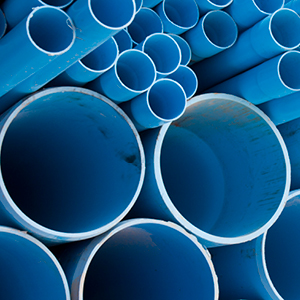
Water Delivery
In applications from water delivery and sprinkler systems to sewage transport and drain-waste-vent, vinyl plays a critical role in providing reliable, durable piping service.
Piping is an important, functional part of most buildings, and vinyl pipe offers unsurpassed reliability and durability. Although seldom seen, it is needed to deliver clean water for drinking and other purposes. It is also needed to convey waste water away from buildings for treatment and subsequent reuse. A variety of piping materials is available today. Foremost among them is polyvinyl chloride or PVC.
PVC pipe has revolutionized piping systems around the globe for the last 70 years. Read more about the benefits of PVC pipe in our latest report “PVC Pipe: The Proven Solution for America’s Infrastructure.”
PVC is:
- The predominant material used in drain, waste and vent applications.
- Used extensively in cold water delivery systems to and for buildings.
- Formulated as chlorinated polyvinyl chloride (CPVC) pipe for use in hot and cold water delivery systems in buildings.
- Used in larger diameter piping applications outside buildings for water distribution and transmission, sanitary sewers, storm sewers and culverts and industrial piping systems.
- PVC pipe is available in a variety of lengths, diameters and pressure classes. It has a full complement of standard fittings, valves and couplings.
- And it is compatible with other pipe materials, so it can be specified for either new construction or system upgrades.
Water Saving
Some 2.6 trillion gallons of water are lost annually in the United States alone, primarily as a result of premature pipe corrosion leaks and breaks. This amount of lost water would satisfy the drinking water needs of every man, woman and child on earth for a year. The annual lost revenue to water utilities is estimated to total $2.98 billion.
The aging and deteriorating U.S. water infrastructure consists mostly of cast iron and ductile iron pipe. Highly susceptible to corrosion, these systems account for hundreds of water main breaks a day throughout North America. A solution to this problem is PVC pipe.
The largest amount of vinyl resin produced in the United States goes into PVC pipe. Being immune to corrosion and its overall durability has made PVC pipe a popular choice for clean water distribution systems, and sanitary collection of waste water.
PVC pipe accounts for more than 70 percent of new buried water distribution pipes being installed in the United States and Canada. More than 75 percent of newly installed sanitary sewer systems feature PVC pipe.
Municipalities also are finding that PVC can be a benefit in pipe rehabilitation.
A new the ANSI/NSF 61-certified PVC water line renewal system is making the traditional dig-and-replace method obsolete. PVC liners can be inserted through existing lines, with minimal excavation, then pumped through with hot water to make the liners expand and mold to the old lines’ interiors.
But perhaps even more important, water utility managers who have chosen PVC are leaving a legacy of good stewardship for future generations. By increasing the useful life of new infrastructure, a utility will eventually relieve future managers, water system ratepayers and even the federal government from the burden of constant system repair and replacement. By selecting PVC product with a predicted life exceeding 100 years, the replacement crisis systems currently face every 20 to 30 years will be a thing of the past.
For more information on PVC pipe, please visit the Uni-bell PVC Pipe Association (PVCPA) and the Plastic Pipe and Fittings Association (PPFA).

